Thank you for visiting! By the way… any links on this page that lead to products on Amazon and other stores/partners are affiliate links Aquarium Store Depot earns a commission if you make a purchase.
Cherry shrimp (Neocaridina davidi) make fun and fascinating pets that look amazing, especially in a planted aquarium. The problem many aquarists face is that these tiny crustaceans are so difficult to find tank mates for. It seems like just about every fish out there wants to eat these peaceful inverts!
Well, I understand your concerns and that’s why I’ve put together this list of 12 awesome (and safe!) cherry shrimp tank mates. I’ll also run you through their basic care needs so you can start your cherry shrimp community tank with confidence.
Let’s dive right in!
Cherry Shrimp Care – The Basics
Cherry shrimp are very small, delicate creatures that are pretty much at the bottom of the aquarium food chain. The foundation of any good cherry shrimp community tank is providing the perfect conditions for your dwarf shrimp to thrive and even breed.
Let’s take a look at some basic facts about cherry shrimp.
- Scientific name: Neocaridina davidi
- Origin: China
- Adult size: 1-1.6 inches
- Minimum take size: 2 gallons
- Care level: Easy
- Die: Omnivorous
- Temperature: 65-84°F, with about 73°F being ideal
- pH: 6.5-8
- GH: 4-8 dGH
- KH: 3-15 dKH
Choosing Tank Mates For Cherry Shrimp – What You Need To Know
Keeping cherry shrimp with just about any fish is risky. A lot depends on the personality of the fish and even the layout of your tank. Here are some important factors to consider:
Size
There is a simple rule that all experienced fish keepers know, don’t put small fish together with anything big enough to swallow them whole. The same rule applies to dwarf shrimp of course, but it’s not always that simple.

Small size cherry shrimp and babies will be vulnerable to almost all aquarium fish. Some small fish will also pick at the shrimp, so they don’t necessarily need to be able to swallow them whole to do serious damage. The safest bet is to go for small tank mates with very small mouths.
Temperament
Some fish are more aggressive than others. Silvertip tetras, for example, tend to be very nippy fish and they can pick at your shrimp even if they aren’t going to eat them. Bettas and gouramis can also be aggressive towards shrimp in the same way.
Competition
Shrimp are very small creatures and they can be easily outcompeted for food sources by larger, faster fish. Even slow-moving tank mates can outcompete shrimp if their numbers are high enough. Bladder snails and ramshorn snails, for example, can multiply pretty quickly in the right conditions!
Baby Safety
Female shrimp keep their eggs safely under their tails instead of laying them in the tank. When the eggs hatch, however, the tiny shrimplets are highly vulnerable to even the smallest fish in freshwater aquariums.
Keeping baby shrimp (shrimplets) safe from tank mates can be very difficult. If you plan on breeding your shrimp and getting the best survival rate, a shrimp-only tank is going to be your best bet!
Baby shrimp can survive to adulthood in a community tank, however, the secret is to provide the kind of cover for them to hide and stay safe. Live plants like Java moss that provide plenty of hiding spots are the best options.
Have A Backup Plan!
The number one most important piece of advice when setting up any community aquarium is to have a plan B. A small quarantine tank that holds a few gallons is ideal for moving any troublemakers away from your cherry shrimp and other fish.
All you need is a hood, a small filter, and a heater to complete this setup which can also be used for quarantining new fish, breeding projects, or treating sick livestock.
Best Tank Mates
Now that you know a little more about the basics of red cherry shrimp tank setup and care, I’m sure you can’t wait to find cherry shrimp friends!
Let’s take a look at some of the best tank mates for cherry shrimp. I’ll list out the following important information for each tank mate:
- Scientific name
- Origin
- Adult size
- Minimum tank size
- Care level
- Diet
- Temperature
- pH
Take note of these stats because you’ll need to keep both your cherry shrimp and their tank mates happy. Check out the video above from our YouTube channel. We go into more detail in our blog post below.
Let’s get started!
1. Amano Shrimp
Best For Planted Tanks!
When it comes to keeping a healthy planted aquarium, Amano Shrimp are the best. These hard-working crustaceans will dutifully wipe your plants and rockwork clean of algae. Their appetite for different types of algae that can't be matched by other shrimp breeds!
- Scientific name: Caridina japonica
- Compatibility: High
- Origin: Japan
- Adult size: 2 inches
- Minimum tank size: 10 gallons
- Care level: Easy
- Diet: Omnivore
- Temperature: 60-80°F
- pH: 6-7.6
Have you ever thought about keeping other shrimp species with your cherry shrimp? Amano shrimp are a great choice because they are super peaceful and they do great in similar water parameters.
Amano shrimp are algae eaters which means they need a well-established tank to stay fed. It’s best to add these guys a few months after setting up the tank.
Amano shrimp are not the only other shrimp species that you can keep with cherry shrimp. Ghost shrimp and vampire shrimp are also great options. Just be sure to avoid crystal shrimp because they prefer different water conditions.
2. Thai Mico Crabs
- Scientific name: Limnopilos naiyanetr
- Compatibility: High
- Origin: Thailand
- Adult size: 0.5 inches
- Minimum tank size: 2 gallons
- Care level: Moderate
- Diet: Omnivorous
- Temperature: 72-82°F
- pH: 6.5-8
Dwarf shrimp are not the only awesome crustaceans that you can keep in your tank. Thai micro crabs (video source) are really interesting creatures that you can keep in the same tank with your cherry shrimp.
Thai micro crabs are tiny and shy, but you’ll be happy to watch these little whitish or blueish crabs hanging out in your freshwater aquarium.
3. Aquarium Snails
Horned Nerite Snails are excellent algae eaters for planted tanks.
- Scientific name: Varied
- Compatibility: High
- Origin: Varied
- Adult size: 1-2 inches
- Minimum tank size: 5 gallons
- Care level: Easy
- Diet: Omnivorous
- Temperature: 65-82°F
- pH: 6.5-8.5
Almost all freshwater snails go great with shrimp. Snails are great for eating algae and keeping your tank clean too, and they’re really easy to maintain.
Choose your snail species carefully though, some aquarium snails breed out of control. I recommend nerite snails because they look amazing and they can’t breed in your cherry shrimp tank.
4. Otocinclus Catfish
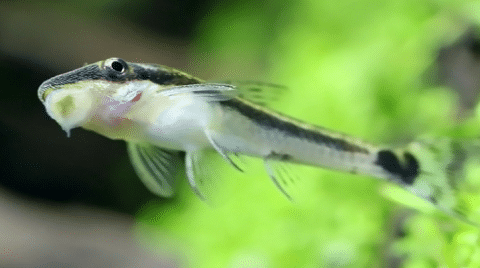
- Scientific name: Otocinclus spp.
- Compatibility: High
- Origin: South America
- Adult size: 2 inches
- Minimum tank size: 10 gallons
- Care level: Easy
- Diet: Algae
- Temperature: 74-79°F
- pH: 6-7.5
Otocinclus catfish are probably the safest fish species that you can keep with cherry shrimp. These nano sucker fish are specialized algae eaters so they’re perfectly safe, even with baby cherry shrimp!
These fish do an amazing job of keeping aquariums clean too, just make sure to add them to mature aquariums so they’ll have enough food to eat.
5. Neon Tetra

- Scientific name: Paracheirodon innesi
- Compatibility: High
- Origin: South America
- Adult size: 0.8-1.2 inches
- Minimum tank size: 10 gallons
- Care level: Easy
- Diet: Omnivore
- Temperature: 70-77 °F
- pH: 6-7
Neon tetras are very peaceful fish with very small mouths. These nano fish are a safe bet with adult cherry shrimp but they will eat baby shrimp if they get the chance, so make sure you provide plenty of cover like Java moss. These brightly colored fish look great with blue velvet shrimp.
6. Ember Tetra
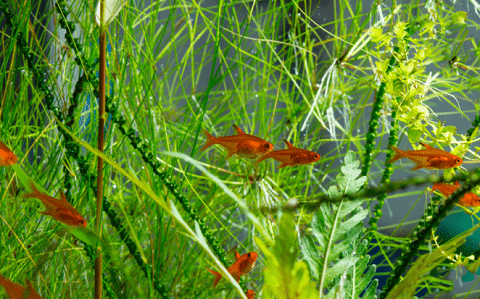
- Scientific name: Hyphessobrycon amandae
- Compatibility: High
- Origin: Brazil
- Adult size: 0.75 inches
- Minimum tank size: 10 gallons
- Care level: Easy
- Diet: Carnivore
- Temperature: 72-77°F
- pH: 5-7
The ember tetra is a very small fish that can make a great tank mate with cherry shrimp. Their bright colors match perfectly with fire red cherry shrimp and other red breeds like the sakura cherry shrimp.
These fish are super peaceful so they will get along with any other tank mates of a similar size. Ember tetras, like neon tetras, are schooling fish so pick up a group of at least 6.
7. Chili Rasbora
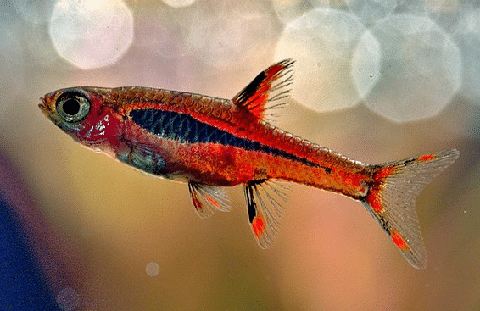
- Scientific name: Boraras brigittae
- Compatibility: High
- Origin: Borneo
- Adult size: 0.75 inches
- Minimum tank size: 5 gallons
- Care level: Easy
- Diet: Carnivore
- Temperature: 68-82°F
- pH: 4-7
Chili rasboras are awesome nano fish that can live peacefully with cherry shrimp. They are beautiful little red fish with great black markings. These schooling fish are truly tiny, so they pose no threat to your adult cherry shrimp.
Chili rasboras prefer slightly acidic water so they are going to work best if your pH is between 6.5 and 7. Keep a group of 6 or more of these fish in a heavily planted tank for an awesome nano aquarium.
8. Corydoras Catfish

- Scientific name: Corydoras spp.
- Compatibility: High
- Origin: South America
- Adult size: 1-4 inches
- Minimum tank size: 10-30 gallons
- Care level: Easy
- Diet: Omnivore
- Temperature: 74-80°F
- pH: 7-8
Corydoras catfish are another great tank mate for cherry shrimp. The safest cory catfish are going to be the pygmy cory (C. pygmaeus) and dwarf cory (C. hastatus).
These tiny fish are not bottom dwellers like the larger species and tend to hang out in the open water column. Just be sure to buy a nice big school so they can swim around together in the midwater of your tank.
9. Endler’s Livebearer
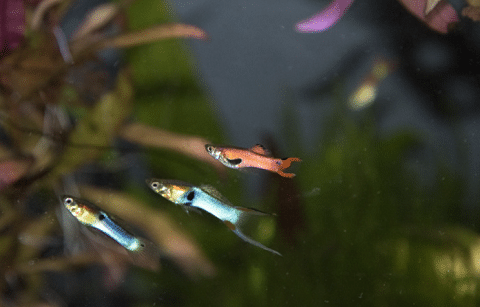
- Scientific name: Poecilia wingei
- Compatibility: High
- Origin: Venezuela
- Adult size: 1 inch
- Minimum tank size: 10 gallons
- Care level: Easy
- Diet: Omnivore
- Temperature: 64-82°F
- pH: 5.5-8
Endler’s livebearers are similar to guppies but don’t grow quite as large. These awesome colorful fish are very easy to care for and they won’t bother adult shrimp.
Endler’s livebearers breed quickly if you keep males and females in the same tank, however, so be ready to find homes for lots of baby fish! The males are smaller and more colorful than the females so you could keep only males if you want to avoid breeding. They will be pretty territorial though, so keep a nice big group of 6 or more to spread out any conflict.
10. Pencil Fish
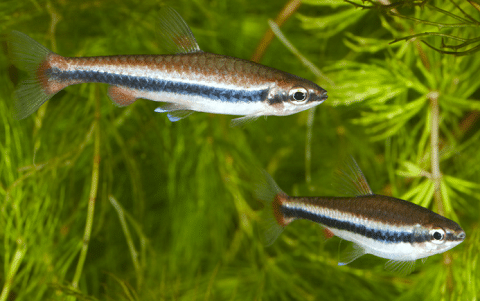
- Scientific name: Nannostomus spp.
- Compatability: Moderate
- Origin: South America
- Adult size: 1.5 – 2 inches
- Minimum tank size: 10 gallons
- Care level: Moderate
- Diet: Carnivorous
- Temperature: 72-82°F
- pH: 6-7.4
Pencil fish can also make great tank mates for cherry shrimp. These interesting schooling fish from South America have tiny mouths and they also swim towards the surface of the tank, keeping them out of contact with your cherry shrimp.
There are many great pencil fish species to choose from in the aquarium hobby. Beckford’s pencil fish (N. beckfordi) is a great option because they are pretty easy to find and care for.
11. Clown Killifish
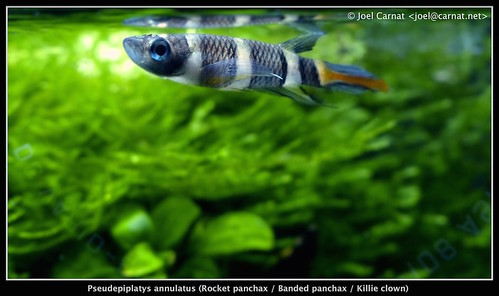
- Scientific name: Epiplatys annulatus
- Compatability: Moderate
- Origin: West Africa
- Adult size: 1.25 inches
- Minimum tank size: 10 gallons
- Care level: Moderate
- Diet: Carnivore
- Temperature: 68-79°F
- pH: 4-7
Clown killifish make interesting tank mates for cherry shrimp. These tiny fish tend to hang out at the top of the tank while the cherry shrimp are foraging down below on the substrate, so they usually stay out of each other’s way.
Clown killifish are predators, so they will feed on baby shrimp. Keeping these tank mates together would be safest in a heavily planted tank with loads of cover. You should always have a solid backup plan, however, especially if you keep higher-graded shrimp.
12. Kuhli Loach

- Scientific name: Pangio kuhlii/ semicincta
- Origin: Southeast Asia
- Adult size: 3-4 inches
- Minimum tank size: 15 gallons
- Care level: Easy
- Diet: Carnivore
- Temperature: 70-79°F
- pH: 3.5-7
Kuhli loaches are one of my favorite nano bottom dwellers. These strange fish have beautiful markings and they’re really peaceful too. They do a great job of cleaning up leftover food at the bottom of the tank, but they are pretty shy during the daytime, so they’re not the best display fish.
Tank Mates To Avoid
Unfortunately, the list of fish that you can’t keep with shrimp is much longer than the list of fish that you can. Of course, you should avoid any large or predatory fish, but some popular aquarium fish should also be avoided.
Here are 5 popular types of fish that don’t go well with cherry shrimps.
1. Goldfish
Goldfish love to snack on red cherry shrimp. It is possible to keep them together but only if you don’t mind losing shrimp to your goldfish.
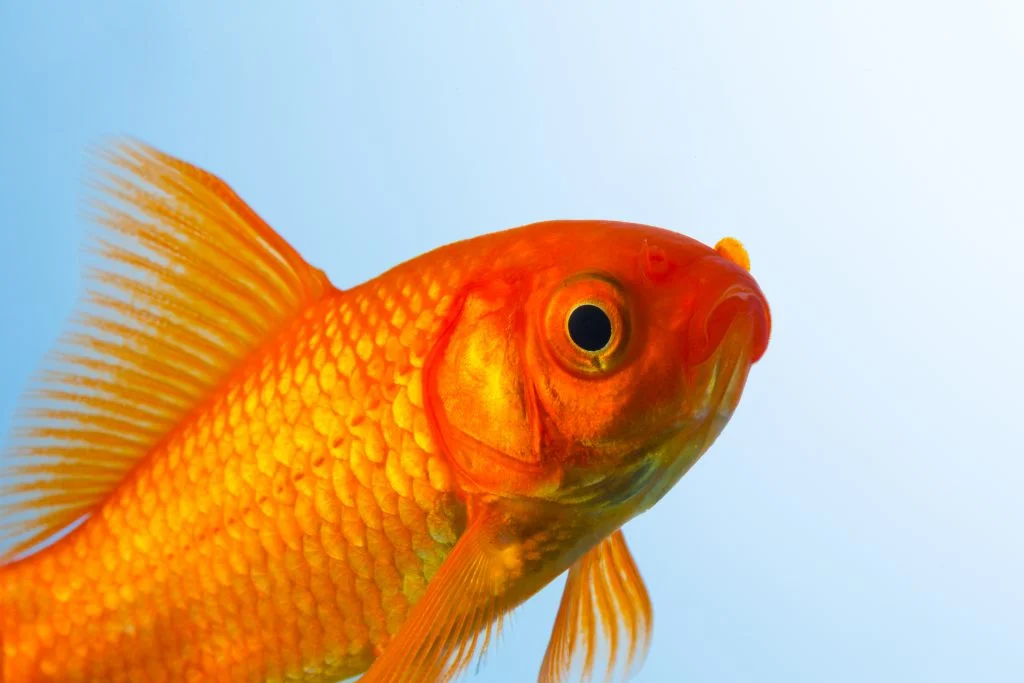
Common goldfish and other fast swimming breeds like comets are a definite no-no, but slow-moving fancy goldfish might not eat all of your cherry shrimps.
2. Cichlids
Cichlids are definitely not safe tank mates for cherry shrimp. Even the species that don’t eat invertebrates can be aggressive and kill your red cherry shrimp.
3. Rainbowfish
Rainbowfish have been known to make pretty short work of even adult shrimps. This is one fish you should definitely keep out of your cherry shrimp tank!
4. Betta Fish
Some betta fish don’t seem to care about sharing a tank with cherry shrimp. Others will absolutely decimate your shrimp colony in no time at all!
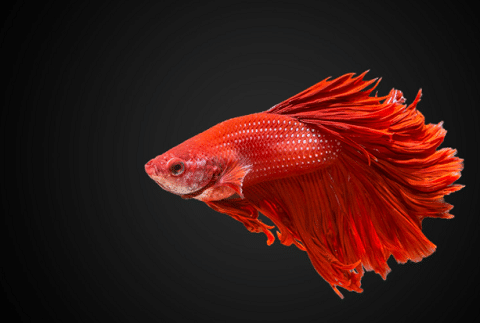
This is one pairing that is best to avoid. If you must try it, a slow-moving betta with large fins is going to be your safest bet.
5. Dwarf Cichlids
You probably weren’t surprised to learn that larger cichlids are not peaceful tank mates for cherry shrimp. Unfortunately, the smallest species like rams and apistos will also peck at your cherry shrimp.
Community Tank Setup
Read this section to learn how to create an awesome cherry shrimp community tank.
Introducing Tank Mates
It is best to introduce your cherry shrimp long before you add their tank mates. This will give them a chance to settle in and get comfortable in the aquarium. If all goes well, they might even start breeding, which could make up for any losses from hungry tank mates.
Tank Size
Cherry shrimp can be kept in tanks as small as 2 gallons, but if you’re looking to set up a community tank, I would suggest looking at a 10 to 15-gallon tank at a minimum. This will allow you to keep a nice school of something like neon tetras, a few nerite snails, and maybe even a few kuhli loaches if you have good filtration.
The absolute minimum tank size for a community tank with fish would be a 5-gallon setup with a small school of chili rasboras and some red cherry shrimp.
Heating & Filtration
You’re going to need a small heater to keep your water temperature stable in the cherry shrimp’s preferred range. Take care to choose a heater model that matches your tank size and use a thermometer to easily monitor the water temperature in your aquarium.
Some people have managed to keep shrimp without a filter, but this is a bad idea if you ask me, especially if you are going to be keeping fish with your shrimp. A sponge filter, an air pump, and some tubing are all you will need in most cases.
For larger community tanks, you can also look at a hang-on back or canister filter. Just make sure you cover your filter’s water intake to prevent any curious shrimp from getting sucked in.
Maintenance & Testing
Cherry shrimp require excellent water quality with zero ammonia and nitrite levels. Keeping your cherry shrimp (and their tank mates) healthy in the long run is going to require regular maintenance and water testing.
A test kit is very important for monitoring changes in your water chemistry over time. In fact, you’ll need to test your water before you even add your cherry shrimp to confirm that your water parameters are good for them.
Pick up a test kit that can measure the following parameters:
- pH
- GH
- KH
- Ammonia
- Nitrite
- Nitrate
Perform a partial water change when your nitrate levels reach about 20 ppm. They can go a little over this for short periods but it will start getting dangerous for your pets.
Nitrate levels will increase at about the same rate every week if you have the same number of shrimps and livestock, and provide the same amount of food. With regular testing, you can work out the ideal maintenance schedule for your aquarium.
Substrate & Decorations
Red cherry shrimp can be kept over pretty much any aquarium-safe substrate for freshwater tanks. Gravel or sand make great choices for lightly planted tanks but a complete aquarium soil would be a better choice for a heavily planted aquascape.
Any ornament or decoration that is designed for aquarium use will provide a great place for cherry shrimp to hide and forage. Natural materials like driftwood and lava rock work great too.
Cholla is best known for being an excellent wood for pet shrimp
Live Plants For Your Freshwater Shrimp Tank
Live plants and cherry shrimp are a perfect combination. Plants provide the shrimp with excellent foraging grounds, as well as cover for the baby shrimp to hide in.
Both female and male cherry shrimp molt about once a month. The hiding spots provided by the plants will also keep them safe as their shell hardens.
Plants also oxygenate the water and improve water quality for your shrimp and their tank mates by soaking up excess nitrates. Live plants also look amazing, and they’re great fun to grow too! Java moss is the go-to plant for shrimp keepers but dwarf hair grass is also a great option.
The following other plant species make great choices for cherry shrimp community tanks:
- Java fern
- Anubias
- Water wisteria
- Water lettuce
Feeding & Diet
Cherry shrimp will happily munch on uneaten food, but you should also provide them with a well-balanced diet of blanched vegetables and shrimp pellets. There are some excellent shrimp food products on the market like Dennerle’s Shrimp King Food that really enhances their colors.
Great For Freshwater Shrimp!
A color enhancing food for shrimp that will help intensify yellows, oranges, and most importantly red!
Do not overfeed your fish and shrimps as this can lead to dangerous ammonia spikes. Remember, uneaten fish food and algae already provide a proportion of the food your cherry shrimps need.
Where To Buy Tank Mates
Most of the tank mates in this article can be found pretty easily by visiting your local fish store. Some of the less common species like Thai micro crabs will be much easier to find online, however. You can also buy them directly at the link below!
Great red color and very hardy. Cherry shrimp are the best beginner shrimp for shrimp tanks
FAQs
What fish can I put with my shrimp?
Most tropical aquarium fish cannot be trusted with cherry shrimp. There are some great tank mates for red cherry shrimp that fish keepers all over the world have kept with success, however. Small tank mates like neon tetras, chili rasboras, and dwarf cory catfish all make great tank mates.
How many should be together?
You should keep at least 10 cherry shrimp together in your shrimp tank. These tiny crustaceans prefer to hang out together in big groups in nature. Keeping a group of at least then will make your cherry shrimp feel more comfortable, and also improve their chance of breeding and growing a healthy colony.
What fish will not eat them?
The safest fish you can put in with your cherry shrimp is the otocinclus catfish. They are one of the only fully shrimp-safe tank mates for cherry shrimps.
Final Thoughts
Putting together a shrimp-safe community aquarium can be pretty nerve-wracking, but by choosing one or more of the awesome tank mates on this list you should have very little to worry about! Remember to have a backup plan in case anything goes wrong and consider growing some fine plants like java moss to give the baby shrimp a safe place to hide.
What is your favorite tank mate for cherry shrimps? Let us know in the comments below!
- About the Author
- Latest Posts
I’m thrilled that you found Aquarium Store Depot! Here you’ll find information on fish, aquariums, and all things aquatics related. I’m a hobbyist (being doing this since I was 11) and here to help other hobbyists thrive with their aquariums! I adhere to a high quality Editorial Process and Review products with real life field usage and practical analysis.

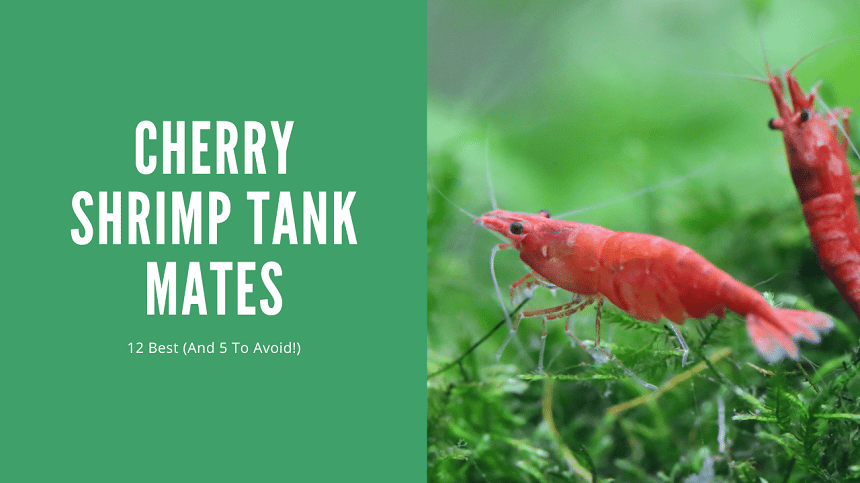









I have kept black neon tetra green neon rasbora and copper harlequins with my cherry shrimp in a 64litre tank